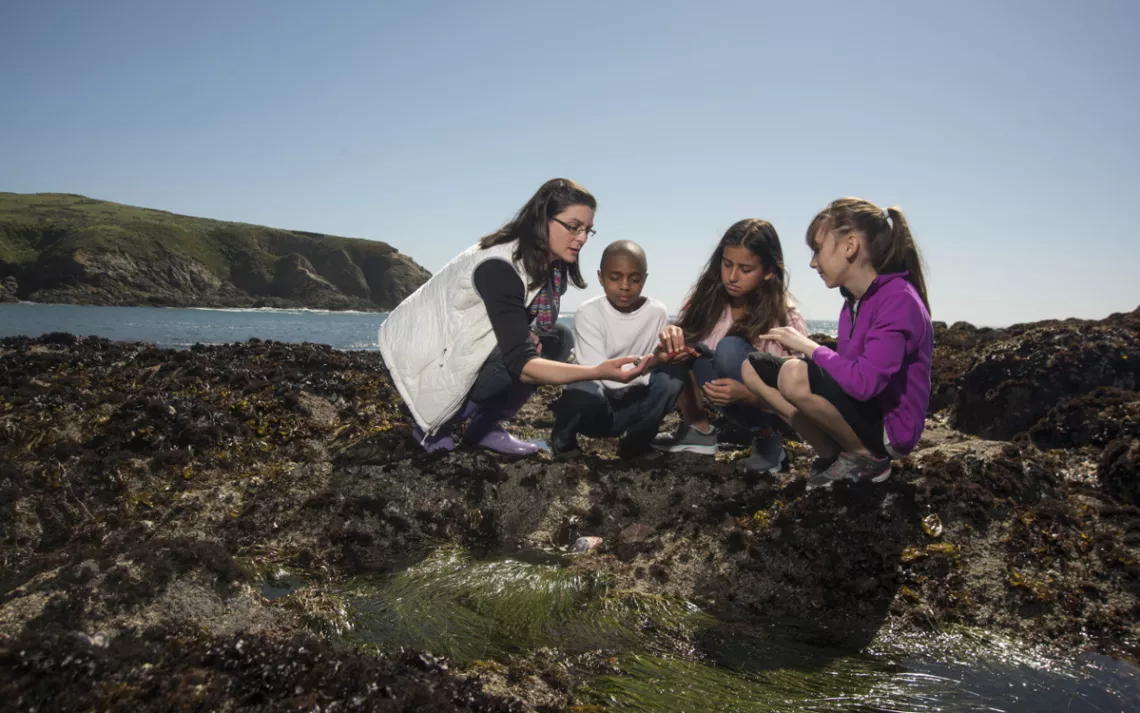The Paleo Climate of California
What ancient coral can tell us about climate change

Tessa Hill working in the intertidal and talking to kids about how the ocean is changing. | Photo: Karen Higgins, UC Davis
Decoding the growth rings of long-living trees like redwoods—species of which can live for 3,000 years—is akin to peering back in time. Drought, flood, fire, and other climate events affect a tree’s health across history and can be read in the chemical analysis of a given year of growth. Ice cores from the Arctic, sediment from the ocean floor, and mineral deposits from caves also reveal data embedded in the earth.
Corals are a recent addition to this body of prophecy. Scientists now know that deep-sea corals off the coast of California live for hundreds of years—and they record a ring for every year of their growth, just like a redwood. What their growth rings tell us about past ocean conditions can also illuminate our planet's future.
California’s deep-sea corals and nearshore fossils can tell us stories about the ocean’s longtime norms, and our own more recent effects in the Anthropocene, says Tessa Hill, professor of earth and planetary sciences at the University of California, Davis. They can also tell us what we’re in for when it comes to climate change in the years to come.
The field of paleoclimatology—the study of past climate change on our planet—is booming. For Dr. Hill, the most critical answers are still waiting to be discovered. How did the growth rates of these corals change over the past decade, versus their couple-hundred-year lifetime? Are they having a harder time calcifying their skeletons? Is food scarcer? A close look at the geochemistry of a coral skeleton can reconstruct temperature and pH changes, and what that coral is eating over time.
Dr. Hill and graduate student Carina Fish are currently collecting coral samples from offshore with the help of research vessels and robot submersibles. Back in the lab, “you can get the full story of that coral by taking a slice of it,” Hill says. With microscopes, scientists count rings, recording size differences to determine growth patterns; with mass spectrometers, they can date oxygen and carbon isotopes across a specimen. The oldest coral they’ve studied is 400 years old. In the same way that looking at information in the geological record can improve the accuracy of sea level rise projections, looking at long-lived corals can tell us about warming conditions, and the ebb and flow of marine life.
Arctic glaciers, the redwood forests of California, and the ocean’s coral ecosystems are at high risk from even small changes in global mean temperature. They can't get up and relocate; they absorb and reveal the effects of climate change in their accumulated years. Absent a historical analog for the unprecedented rapid changes of the present day—in the chemistry of our atmosphere, our land, our oceans—the paleo record is a way to illustrate how global warming can profoundly alter life on the planet. As Kate Marvel, a climate scientist at Columbia University recently wrote, “Dead things, bubbles in ice cores, layer of sediment: Together, these provide glimpses in what once was. They testify to the power of the atmosphere to change the earth.”
In 2015, Dr. Hill, Sarah Moffit, and other researchers published a paper showing that marine ecosystems on the seafloor of the eastern Pacific Ocean experienced abrupt warming about 10,000 years ago, as the earth came out of its previous glacial period. It took millennia for those ecosystems to recover to a stable state.
Dr. Hill is currently leading a major follow-up research effort in partnership with the California Academy of Sciences, to collect and catalog nearshore fossils along the coast of Southern California; she and graduate student Hannah Palmer will investigate marine ecosystems over multiple stages of upheaval and recovery in the past 10,000 years. Their goal: When we look back 100 years from now, what is the moment where we pinpoint that human influence is so big that we have to call it out from a geologic standpoint?
“It is much easier to discern tipping points in the rearview mirror—once you have passed one, not while you are in one,” Dr. Hill says. “People often refer to the danger that we might pass a tipping point in the earth’s climate system. One really important thing we are learning from the paleoclimate record is the causes and consequences of these tipping points. If we study time periods of significant change in the paleoclimate record, we learn how the earth’s climate system and ecosystem responds to perturbation—and perhaps recovers.”
Studying paleoclimate can be frightening, says Dr. Hill, because we have such clear examples of how much havoc can be wreaked. Her way of tackling that fear is to use her research as a wake-up call. “My futurist optimistic self is hoping that people will take these lessons from the paleoclimate record seriously, and act quickly,” she says. Knowing about tipping points only matters if we change how we behave in response to that knowledge.
Tree rings and coral rings are a bridge to our understanding of deep time, a geological time scale that most of us can't really fathom. They are snapshots of the paleo climate of our planet and, if we look at them carefully, a glimpse of future consequences of the climate we have been shaping for some time. But there is no perfect analog for what we’re doing now. There’s something we need to understand about the rings that are being created today: For better or worse, they are all our own.
 The Magazine of The Sierra Club
The Magazine of The Sierra Club



